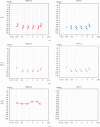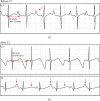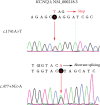Jervell and Lange-Nielsen Syndrome due to a Novel Compound Heterozygous KCNQ1 Mutation in a Chinese Family
- PMID: 32508908
- PMCID: PMC7246397
- DOI: 10.1155/2020/3569359
Jervell and Lange-Nielsen Syndrome due to a Novel Compound Heterozygous KCNQ1 Mutation in a Chinese Family
Abstract
Jervell and Lange-Nielsen syndrome (JLNS) is a rare but severe autosomal recessive disease characterized by profound congenital deafness and a prolonged QTc interval (greater than 500 milliseconds) in the ECG waveforms. The prevalence of JLNS is about 1/1000000 to 1/200000 around the world. However, exceed 25% of JLNS patients suffered sudden cardiac death with kinds of triggers containing anesthesia. Approximately 90% of JLNS cases are caused by KCNQ1 gene mutations. Here, using next-generation sequencing (NGS), we identified a compound heterozygosity for two mutations c.1741A>T (novel) and c.477+5G>A (known) in KCNQ1 gene as the possible pathogenic cause of JLNS, which suggested a high risk of cardiac events in a deaf child. The hearing of this patient improved significantly with the help of cochlear implantation (CI). But life-threatening arrhythmias occurred with a trigger of anesthesia after the end of the CI surgery. Our findings extend the KCNQ1 gene mutation spectrum and contribute to the management of deaf children diagnosed with JLNS for otolaryngologists (especially cochlear implant teams).
Copyright © 2020 Yue Qiu et al.
Conflict of interest statement
The authors declare that they have no competing interests regarding the publication of this paper.
Figures





Similar articles
-
"Homozygous, and compound heterozygous mutation in 3 Turkish family with Jervell and Lange-Nielsen syndrome: case reports".BMC Med Genet. 2017 Oct 16;18(1):114. doi: 10.1186/s12881-017-0474-8. BMC Med Genet. 2017. PMID: 29037160 Free PMC article.
-
Identification of KCNQ1 compound heterozygous mutations in three Chinese families with Jervell and Lange-Nielsen Syndrome.Acta Otolaryngol. 2017 May;137(5):522-528. doi: 10.1080/00016489.2016.1260156. Epub 2016 Dec 5. Acta Otolaryngol. 2017. PMID: 27917693
-
Identification of a novel KCNQ1 mutation associated with both Jervell and Lange-Nielsen and Romano-Ward forms of long QT syndrome in a Chinese family.BMC Med Genet. 2008 Apr 9;9:24. doi: 10.1186/1471-2350-9-24. BMC Med Genet. 2008. PMID: 18400097 Free PMC article.
-
[Jervell and Lange-Nielsen syndrome].Lin Chuang Er Bi Yan Hou Tou Jing Wai Ke Za Zhi. 2019 Sep;33(9):825-829. doi: 10.13201/j.issn.1001-1781.2019.09.007. Lin Chuang Er Bi Yan Hou Tou Jing Wai Ke Za Zhi. 2019. PMID: 31446697 Review. Chinese.
-
KCNQ1 mutations associated with Jervell and Lange-Nielsen syndrome and autosomal recessive Romano-Ward syndrome in India-expanding the spectrum of long QT syndrome type 1.Am J Med Genet A. 2016 Jun;170(6):1510-9. doi: 10.1002/ajmg.a.37636. Epub 2016 Apr 4. Am J Med Genet A. 2016. PMID: 27041150 Review.
Cited by
-
Identification of Novel Compound Heterozygous MYO15A Mutations in Two Chinese Families with Autosomal Recessive Nonsyndromic Hearing Loss.Neural Plast. 2021 May 14;2021:9957712. doi: 10.1155/2021/9957712. eCollection 2021. Neural Plast. 2021. PMID: 34093702 Free PMC article.
-
[The value of genetic diagnosis of deafness in evaluating the prognosis of cochlear implantation].Lin Chuang Er Bi Yan Hou Tou Jing Wai Ke Za Zhi. 2021 Mar;35(3):274-281. doi: 10.13201/j.issn.2096-7993.2021.03.020. Lin Chuang Er Bi Yan Hou Tou Jing Wai Ke Za Zhi. 2021. PMID: 33794619 Free PMC article. Chinese.
-
Behavior of KCNQ Channels in Neural Plasticity and Motor Disorders.Membranes (Basel). 2022 May 6;12(5):499. doi: 10.3390/membranes12050499. Membranes (Basel). 2022. PMID: 35629827 Free PMC article. Review.
-
Hearing Screening Combined with Target Gene Panel Testing Increased Etiological Diagnostic Yield in Deaf Children.Neural Plast. 2021 Jul 23;2021:6151973. doi: 10.1155/2021/6151973. eCollection 2021. Neural Plast. 2021. PMID: 34335733 Free PMC article.
-
The Pathological Mechanisms of Hearing Loss Caused by KCNQ1 and KCNQ4 Variants.Biomedicines. 2022 Sep 12;10(9):2254. doi: 10.3390/biomedicines10092254. Biomedicines. 2022. PMID: 36140355 Free PMC article. Review.
References
Publication types
MeSH terms
Substances
LinkOut - more resources
Full Text Sources

